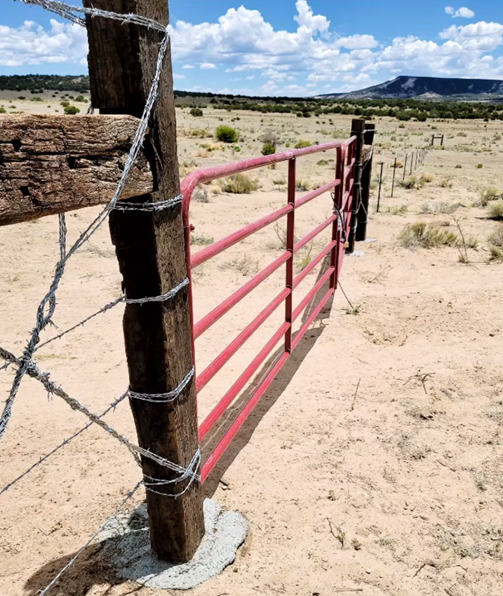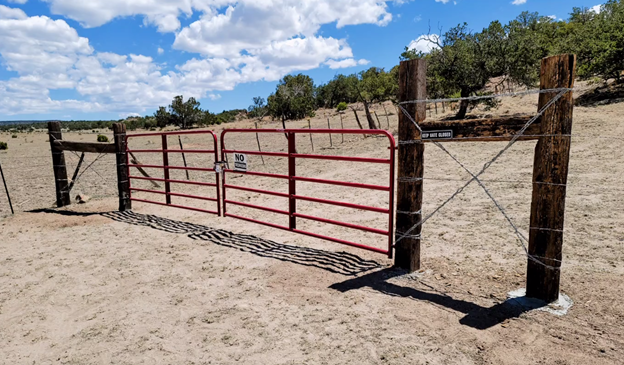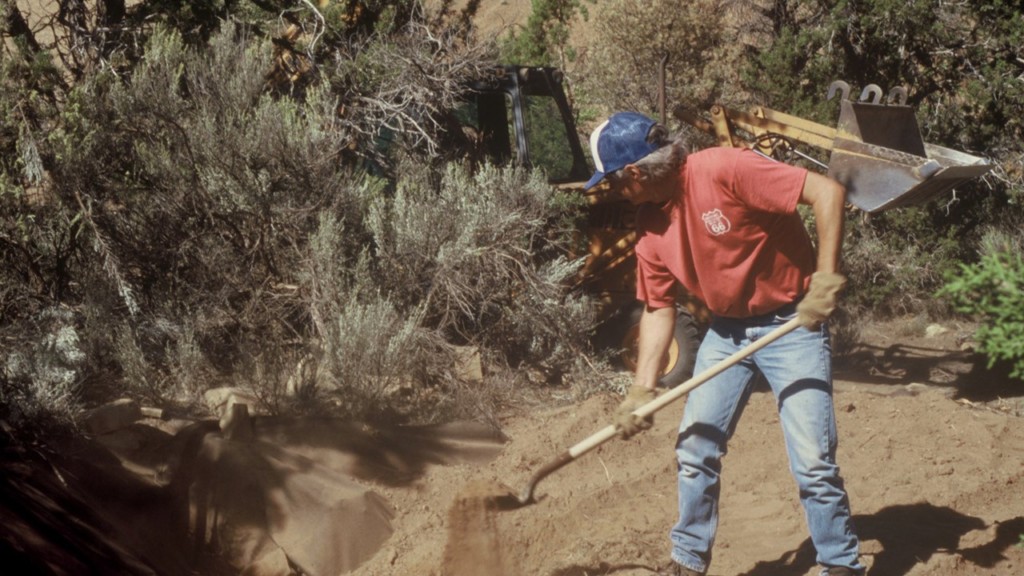The Archaeological Conservancy has established almost 600 sites in 45 states over the past 44 years. The preservation process for each project is ongoing – starting with acquisition and continuing with the management and maintenance of each site.
Preserving The Past for the Future
Acquisition
The first and usually the largest expense incurred in creating a preserve is the cost of acquiring the land. We rely heavily on foundations, corporations, and large donors to fund land acquisition. This is the initial step taken to create an archaeological preserve. Sometimes the land is donated to the Conservancy. The Davis Ranch site, located just north of Quemado, in west-central New Mexico was donated during the summer of 2015. Davis Ranch consists of five pieces of land, ranging in size from two to 20 acres.

A new perimeter fence installed at the Davis Ranch Site in New Mexico. | Photo: Jim Walker
The five sites comprise two quarries located on mesa tops, and three pueblos on the lowlands beneath the mesas. The mesa tops are covered by a thick blanket of quartz, quartzite, and chert rocks that once served as a source for making tools. Bureau of Land Management (BLM) archaeologists determined that one of the quarries dates to Paleo-Indian period. The other quarry had numerous broken ceramics around it, which could indicate that it was utilized by late-prehistoric groups.
One of the pueblos has seven concentrations of room blocks and three large middens. A mile north is another pueblo, which is located just below the Paleo-Indian quarry. This pueblo features 15 or more rooms and a sizeable midden. The third pueblo is about a quarter of a mile to the north. The pueblos are located above a flood plain where the inhabitants likely planted crops. Ground stone artifacts such as manos collected from numerous locations on the ranch indicate that extensive plant processing was taking place there.
BLM archaeologists also found Tularosa Black-on-White, St. John’s Polychrome, and Windgate Black-on-Red ceramics that were apparently crafted by the Mogollon people, who occupied this area between A.D. 200-1450. The Mogollon produced the earliest ceramics in the American Southwest.
Fencing
Fencing plays a crucial part in the preservation process, not only to deter trespassers, but also to prosecute looters. Most courts, especially in the western US, will not convict individuals for trespassing, property damage, and looting unless that individual had crossed a perimeter fence marked “No Trespassing”.
Fencing usually costs between $3 to $8 a linear foot, depending on where the fence is being built and what type of fence is being constructed. The Conservancy normally uses five-strand wire fences with “T” posts on 20-foot centers and with barbed wire in rural areas where cows are present and smooth wire in urban areas.

New fencing installed at Davis Ranch with the help of the National Trust for Historic Preservation. | Photo: Jim Walker
Davis Ranch was fenced in the Spring of 2021 and was funded by a generous grant from the Southwest Intervention Fund for the National Trust for Historic Preservation. All-terrain vehicles, bikes, and motorcycles are of particular concern for many archaeologists. These vehicles can destroy cultural material and displace artifacts out of their original context. Maintaining a site by fencing provides a barrier and makes it much more difficult for the vehicles to enter the properties. Surface material is especially vulnerable to damage and once an archaeological site has been disturbed, the context of the site can never be reconstructed and the information contained is lost forever.
Management Plan
A management plan is created for all new preserves. The plan is created by a committee which includes the former landowner, adjacent landowners, archaeologists, descendant community members, and neighboring landowners. The meeting is usually a one-day event that is held in a meeting room near the preserve. It includes a morning visit to the site by the committee followed by an afternoon discussion session. The plan is not a consensus document, but instead it represents a forum for ideas about managing the preserve.
The plan is then made available to the Conservancy board members to be considered whenever important decisions about the preserve need to be made. The Management Plan can be revised, expanded, or amended if circumstances at the preserve change.
Site Stewards
The Conservancy recruits volunteer site stewards to assist us in monitoring preserves. These are typically neighbors, local avocational archaeologists, and community members who are interested in preservation. In several states in the SW region, including Arizona, New Mexico, Texas, Colorado, and Utah, there are statewide volunteer site steward programs that we often partner with.
Education and Research
Our preservation work ensures that future generations will be able to continue to learn from our shared cultural heritage. Research done on our preserves must be approved by our Board of Directors. Some of our preserves, such as the Wells Petroglyph Preserve in New Mexico, Arbuckle’s Fort in West Virginia, the Adelbert Smith Family Archaeological Preserve in Utah, and the Nemasket River Village in Massachusetts, are co-managed with other agencies and offer opportunities for various types of visitation. Most of our preserves, however, remain on private property and are closed to the public for their protection and preservation.
We also share virtual tours of some of our sites on YouTube, using drone footage, archival photos, and video from the field to tell the story of the culture(s) represented there. This educates the public about our mission and gives our members and the general public the opportunity to visit a significant site from the convenience of their home.
Mapping
Most of the preserves we acquire lack an adequate archaeological map. Maps are an important planning tool for identifying areas that need backfilling, reseeding, or standing walls that need stabilization. We map our preserves using traditional mapping technique as well as LiDAR. Professionals who specialize in mapping as well as archaeology students often donate their services to the Conservancy.
Backfilling

Backfilling operations at Box S Pueblo.
Sites that have been looted using mechanical equipment require backfilling to protect the remaining intact deposits. If a looted masonry room is left open the walls will eventually succumb to the pressure of surrounding intact deposits and collapse, corrupting the archaeological integrity of the intact adjacent rooms.
Stabilization
The Conservancy conducted an extensive stabilization project in 2013 at Garcia Canyon Pueblito, a Navajo structure built in NW New Mexico between A.D. 1712 and 1722, perched on a boulder 70 feet above Frances Canyon. Working with the professional stabilization team from Salmon Ruins Museum in Bloomfield, NM, the project stabilized and reinforced the structures on the site. This important project was funded by the National Trust for Historic Preservation and the NM Department of Cultural Affairs.

Stabilization work at Garcia Canyon Pueblito.
Revegetation
In the arid Southwest, adequate ground cover is vital to preventing erosion as well as discouraging invasive species of shrubs and grasses. The 196-acre Smith Family Petroglyph Preserve (pictured right) in Utah County, UT, adjacent to Lake Utah. Revegetation of a ½ mile long section of the preserve with native grasses was necessary after a devastating wildfire swept through the preserve in 2020.
How does The Conservancy raise funds?
Funds from the Conservancy come from membership dues, individual contributions, corporations and foundations. Membership dues, gifts and bequests of money, land, and securities are fully tax deductible under section 501(c)(3) of the Internal Revenue Code. Planned giving provides donors with substantial tax deductions and a variety of beneficiary possibilities. For more information, call (505) 266-1540.
BECOME A MEMBER OR MAKE A DONATION TODAY!


